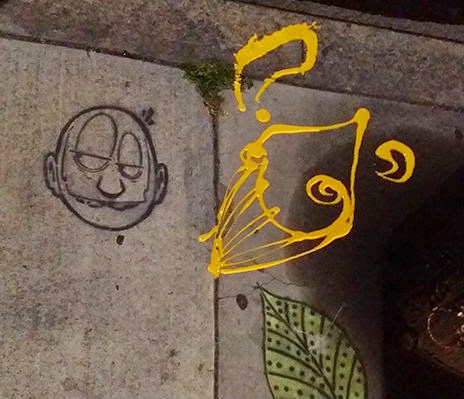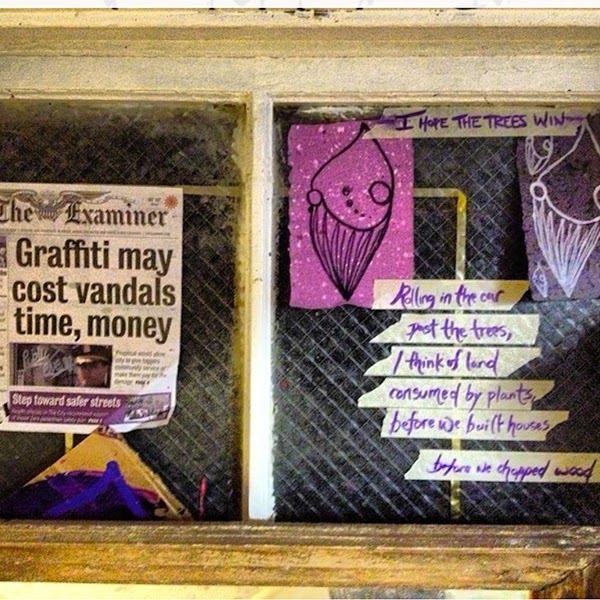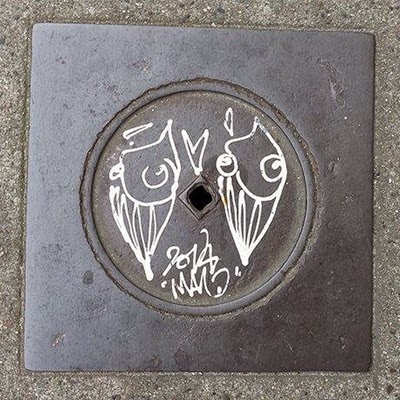
If you've seen a jaunty marine creature scribbled on sidewalks and unexpected corners of the city, you may have wondered just who was behind the tiny tag.
Local archaeologist, young adult fiction writer and screenwriter Eric Vasallo did, and he finally tracked down the elusive Zamar, interviewing him for a larger piece on graffiti for The Writing Disorder. We've excerpted a portion of the article here, with permission from the original source.
---------------------
A July 2014 article in the San Francisco Examiner describes graffiti as a $20 million a year problem, and the debate is as alive and polarized as the slow move towards decriminalizing marijuana in the United States. Each city has a different attitude, from hostile to welcoming, towards it.
"San Francisco appears to have another prolific graffiti artist on its hands who is leaving a mysterious, eye-catching image on public and private property everywhere from Golden Gate Park to Fisherman’s Wharf," reads the article. "The symbol that some have likened to a squid started showing up in recent months on sidewalks, buildings, mailboxes, utility poles, sewer covers, a U.S. postal truck, a passenger van and a hand railing, among other locations. No object seems immune to the unknown tagger."

A recent transplant to San Francisco, I immediately became captivated by graffiti artist Zamar’s squid\octopus meme, which eventually became my muse and secret friend in a place where I had yet to make any. He was my first friend in the city. I would see him everywhere, on my way to the gym, on my way home from a bar, in the bathroom mirror, when I would jump out of a Lyft, I would almost step on the ever jubilant, little guy looking up at me. His googly eyes and mystical scrawled notes like “who knows?” “It could be?” “sunguishguish” were all taunting me to decipher their deeper meaning.
Being a screenwriter, I became obsessed with finding out the backstory of who Zamar really was. I was convinced that there was a story, and that whoever created this character — and brought so much intrigue to so many — had to be special.
After weeks of putting up flyers, searching online for “Zamar” or “Mar” (I wasn’t sure what his real name was), digitally stalking other graffiti artists’ (or "writers") Instagram pages, enlisting local Zamar fans to keep their eyes peeled, I finally found the masked avenger. After more weeks of back and forth Instagram messages, he cautiously agreed to meet with me.
I wasn’t disappointed.
In a dream come true moment, I’m walking with Zamar through Oakland on a Saturday night and his face lights up whenever he shows me a tag, explaining this subculture to me. When he sees a perfect spot to leave a tag, he stops talking, crouches down and with a laser focus, tags four petite Zamars, each one drawn on the bend of a water pipe. His face transforms into a serious and meditatively quiet state as if he were a pregnant octopus giving birth to his larvae. My heart beat faster just to be able to witness this moment of creation.
---------------------
E.A. Vasallo: How did you come up with your animated squid\octopus creature that has haunted and noticed by so many across our city?
Zamar: "I grew up in Baltimore moored on a Crystal Channel Cutter sailboat with my parents and I was home-schooled until about 5th grade. We would travel south to Key West in the winter so I fell in love with the nature and beauty of the Florida Keys. When we’d take our dinghy boat to get supplies, I’d sit and wait for them and look up at the sky. I wanted to represent that peace in my tags. That feeling that all was right with the world while on the ocean. I also consider the octopus as one of the smartest and craftiest creatures of the ocean realm that I’d often fantasize about. Zamar came through that connection with the sea I had as a child.
"Zamar is a compound name joining the letter Z, which I love for its aesthetics combined with the Spanish word “mar” which translates to “ocean”. I looked it up to see if the word existed and coincidentally the word means Hebrew for “praise God.” I believe something happens when you write for so long, it becomes kind of like a mantra that you repeat over and over again, each time you tag your chosen name. I can’t really explain scientifically what happens but there is a sort of transcendence that happens. Which seems to explain why some artists do it until they die. They sort of become possessed."
EAV: What is your motivation for creating Zamar? Does he have a mission?
Z: "I sat at the park at Patricia’s Green in Hayes Valley about a year ago and realized how everyone was on their smart phones and no one was looking at each other at all. Everyone was disconnected. I wanted to create something that would help people connect and feel connected with something. I thought that the ground was the best place for Zamar, below eye level. It’s a natural line of sight for people always looking down at their phones. I try to do things for the public. I am very aware of Zamar’s impact. That’s why I like to tag him near anything that water flows through, like drains, pipes, and sewers.
"For some writers, graffiti is like a void you throw so much time and energy into it and it goes nowhere. But for me, I’d like to make a name for myself eventually. Some writers have built a reputation over the years building interest and buzz slowly.
"My mom was a teacher for the public school system, where she would often try to help kids out from troubled homes. I was in the United Nations club in high school and the Aquarium as a guide for school children. She instilled the ability to look beyond myself and to help others. That’s what is most exciting for me to be in San Francisco because it seems to be a city that cares for its own more than any other city in the U.S. It seems like so many people are planting seeds here. Zamar is my seed."

EAV: Are you afraid of getting arrested for doing your art or graffiti?
Z: "There’s nothing that will stop me. The day that Zamar stops is that day I stop. There’s a tagger that has a phrase he uses in his tags, 'Can’t stop, don’t wanna stop.' A local writer got 'wrapped' which means he got caught, got two nights in jail for a tag in the Tenderloin. I talked to him when he got out and he said he’d keep going because that’s what the true writers do. I feel that way too. It’s a whole world within another world, another dimension and I’m totally stuck in it. As far as going to jail, I feel it’s like when a soldier dies in combat. It’s his ultimate experience. If you really want to take it to the next level you have let stop being afraid and the rules and all the structures that confine you."
EAV: How do you feel about being called a criminal or a vandal and see your little guy on the cover of the San Francisco Examiner?
Z: "It’s amusing how institutions use words to easily demonize those that aren’t in line with what they want. We are not all criminals, or vandals. We are aware and informed citizens. Not all are like that, there are darker ends of the spectrum and some play the line, taunting police.

"I do have a tiff with the institutions that I’m angry at, and this is my way to stick my thumb at it all and it doesn’t require all the bureaucracy to protest it. A lot of writers also use the medium to protest things they don’t like about the community. For example, there’s a writer named “Khy” who’s from the Mission and it means, “keep hoods yours” which is a protest to all the evictions going on these days.
"A lot of these guys have grown up in the Mission and they are upset about how they are being forced to live elsewhere because of skyrocketing property values. That’s why you see tags all over walls when a new store is being built, they will tag the hell out of it in protest because that store pushed out a mom and pop store just so the landlord could get higher rent. Art and vandalism do intersect. Some artists are focused on being a vandal. I am on the other side of the spectrum.
"Some artists are on the side of destructive art and some choose walls that are abandoned or blighted and they put up a large piece, which in their eyes will beautify the public space.
"It sucks that some people have a notion that it’s bad. I think we forget what public space is. We forget what sharing a space is because it gets painted every day. We forget how to really interact with each other. So when you see graffiti, it comes off as shocking because it’s a ripple in the system—a glitch in the matrix of sorts. It’s there and it’s not supposed to be. It causes panic and feeling of loss of control.
"The penalties don’t seem to be effective at stopping it and I don’t believe it’s justified that someone should go to jail for this. There has to be a better way to deal with it. Some writers can get up to three years jail time and a $50k fine. If they are caught with another person it can be considered a gang and those charges are a felony with an increased sentence. Recently, the city has tried to pass a new law to charge artists or as they like to call “vandals” the cost of clean up. The problem with that is these kids usually don’t have any money."

EAV: Are there rivalries or violence amongst writers?
Z: "In the past, graffiti used to be more gang-related. It was kind of incubated there because it was used to mark territories. That’s where most of the stigma for the art form was created. Today it’s not like this. The taggers are a little bit thuggish but it’s mostly a look worn by young kids that don’t have anything to do and are artistically inclined. They don’t really hurt each other. Lots of them work at coffee shops or local markets. It’s not like Al Capone tagging “Al Capone” and killing people. Taggers have gotten killed in the past but it's rare and usually just people at the wrong place at the wrong time like any other murder.
"There is an unwritten rule that you should never tag or post a slap over anyone else’s tag space. No other tagger or writer has come after me but shop owners have. I had a woman throw a trash can on my head while I was finishing up a tag on wet concrete and a shopkeeper chase me down the Mission with what seemed to be a samurai sword yelling “f—king bin rat” at me. That was my all time, harshest diss but I got away both times and finished my tags. In honor of that man, I occasionally tag “bin rat” on recycle bins.
"One guy named Jade, that did a lot for graffiti, died about a year ago. Every now and then taggers will tag his name in honor of him, so there is definitely camaraderie."
EAV: What is the ethnicity or age group of most taggers in the city?
Z: "Most are white guys, mostly young, under 30. One up and coming kid is “Staner”: he’s about 14 and really into graf or writing. Back in the day, Asian writers ran San Francisco and they were excellent at what they did. The most prominent Asian tagger was “Tie” and his real name was Jonathan Lind: he started writing at around 13 and stopped at around 18. He ended up being shot and killed in the '90s while climbing down someone’s fire escape after finishing a tag. The landowner used a justification similar to the Trayvon Martin case and got off scot-free. Tie would tag with another white guy named “MQ” who started really pushing graffiti here in the city and they really made “bombing” or “throwies” popular here. It was based on NYC wild style where the letters are slanted or leaning and filled in with a different color."
EAV: How long have you been tagging in San Francisco?
Z: "For about four years now. It started with a little urge and now it’s become a fire that I can’t put out."
- by Eric Vasallo
---------------------
For more on the art, culture, and current legal climate surrounding graffiti art in the city, go to the original article over at The Writing Disorder.









